 Emily LaBarge
Emily LaBarge
At Tate Modern’s survey of the late artist’s indefinable “abakan” sculptures, a powerful stance against predictability.
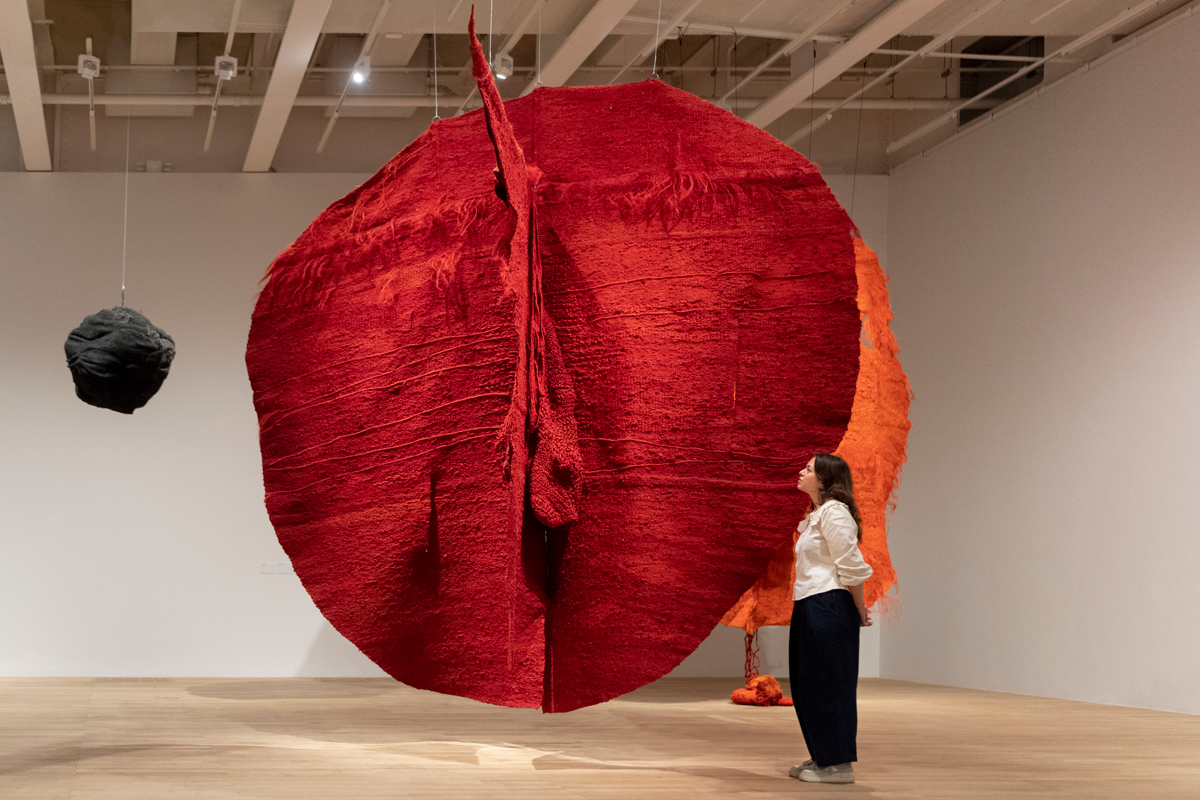
Magdalena Abakanowicz: Every Tangle of Thread and Rope, installation view. © Tate Photography, Madeline Buddo.
Magdalena Abakanowicz: Every Tangle of Thread and Rope, curated by Ann Coxon, Mary Jane Jacob, and Dina Akhmadeeva, Tate Modern, Bankside, London, through May 21, 2023
• • •
Hands and hearts and flesh and lungs. Guts and skin, orifices and incisions. Penile protuberances and labial folds and unabashedly genital swags. Growths and garments, plants and animals, seasons and sentinels, compositions and indefinable shapes in black, brown, crimson, yellow, purple, orange, scarlet, ochre, taupe. Smelling of wool, peat, sackcloth, sisal, and hanging flat against the wall or huge and heavy in three dimensions, Magdalena Abakanowicz’s textile works are unruly and overwhelming, as difficult to classify and contain now as when she began to make them in Warsaw from the 1960s onward. Fumbling for transdisciplinary terms that didn’t yet exist, critics of the moment employed awkward designations, from “painter at the looms” to “sculptor in fabric,” and “painting-like textiles” to (the rather excellent) “carpet-creatures.” In 1964, the Polish critic Elżbieta Żmudzka, seizing the potential of the artist’s anarchic materiality, coined the neologism that Abakanowicz herself would adopt, “Abakans”: neither painting nor textile nor sculpture, but form freed from category and art-historical lineage.
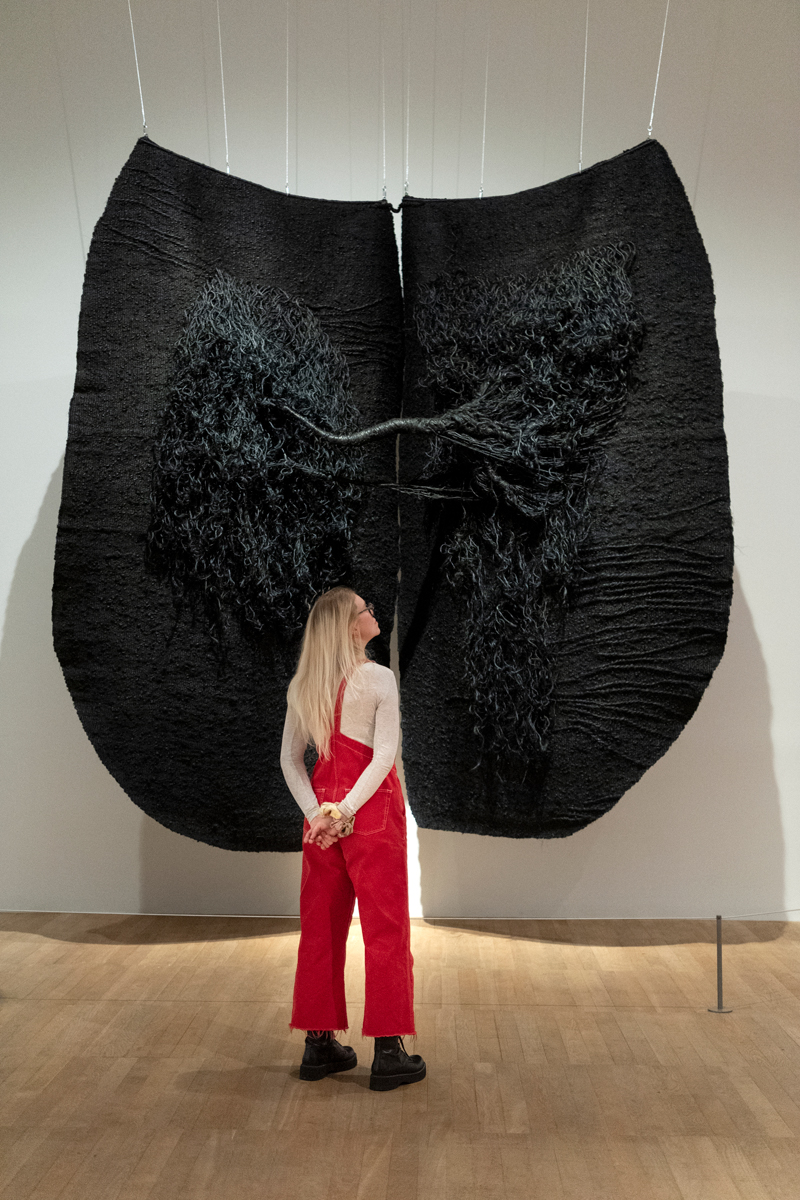
Magdalena Abakanowicz: Every Tangle of Thread and Rope, installation view. © Tate Photography, Madeline Buddo. Pictured: Abakan January – February, 1972.
While Abakanowicz would go on to make art in other mediums, including large public sculptures in bronze, iron, and wood, up until her death in 2017, at age eighty-six, it is the evolution of the Abakans and related works that is the crux of Every Tangle of Thread and Rope. The survey, like the artist’s oeuvre, is at once historical and transhistorical, charting the practical realities of Abakanowicz’s life and art, as well as the often sweeping, cosmological views that underpin her creations and their making. Early pieces made following her graduation, in 1954, from the Academy of Plastic Arts in Warsaw show an artist finding ways to push against the state strictures that governed cultural production and exhibition. During the so-called “post-Stalinist thaw” of the mid-1950s, with its rallying cry of nowoczesność, or “novelty,” certain types of abstraction and formalist experiments became more acceptable to the Polish Communist authorities. Textile art in particular—with its traditionally decorative (rather than representational) associations and links to folk art—was ripe for less controversial experiment.
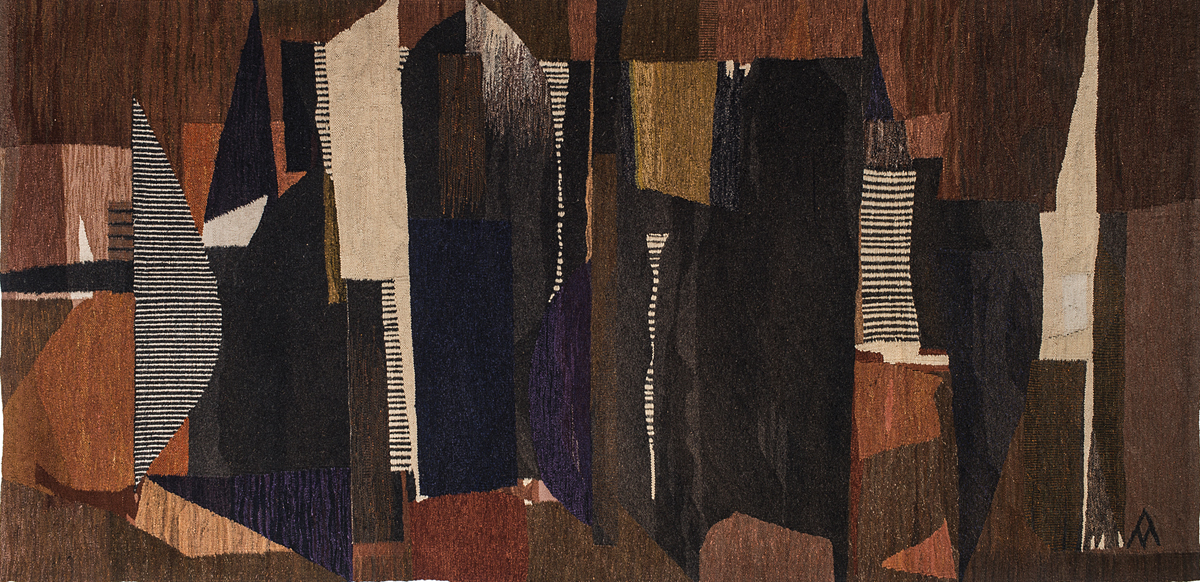
Magdalena Abakanowicz, Tapisserie 21 brune, 1963. Wool. © Fundacja Marty Magdaleny Abakanowicz Kosmowskiej i Jana Kosmowskiego.
A series of wall-based tapestries from the early 1960s moves quickly from unified woven surfaces of controlled geometric studies in color, texture, and pattern, as in Sun (1963) and Tapisserie 21 brune (1963), to bigger works that are raucous and irregular, like Helena (1964–65) and Desdemona (1965). The former were produced within state-run craft programs and followed the conventional labor hierarchies of artist (who made the “cartoon,” or design, for the work), the role Abakanowicz assumed, and weaver (who then executed it at the loom). Helena was commissioned for the 8th São Paulo Biennial in Brazil, and Desdemona was made a year later, on the artist’s own loom built with her growing proceeds, for the 2nd International Tapestry Biennial in Lausanne. Both works are woven directly by the artist’s hand in an unpremeditated, irregular design. Introducing new materials like fleece and horsehair for the first time, these substantial hangings named for historical women are full of movement and surprise. Warp and weft change direction, tilt, amble, arc; knots are smooth and raised, fine and thick; errors and imperfections are absorbed as integral; horsehair spouts and coils from the flat surface as if the works wished to defy the loom, to fly from the wall into other dimensions.
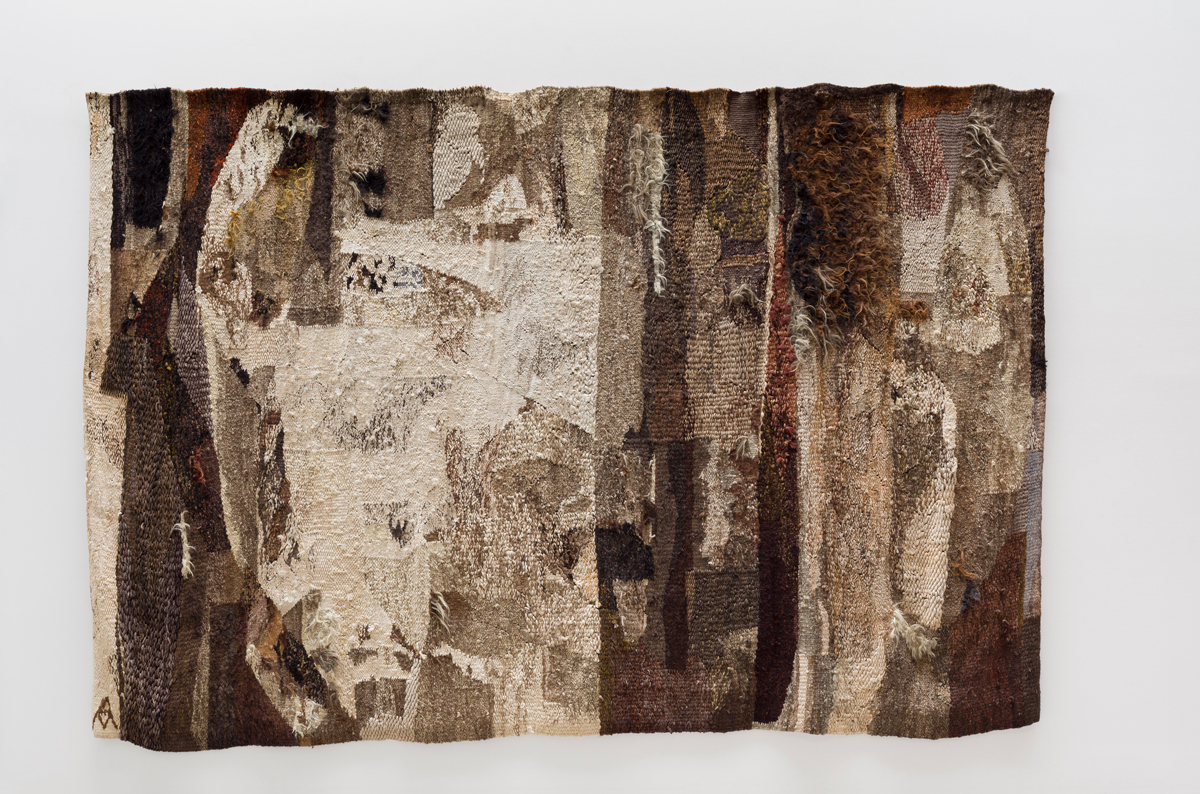
Magdalena Abakanowicz, Helena, 1964–65. Wool, cotton, sisal, horsehair. Courtesy Marlborough Gallery. © Fundacja Marty Magdaleny Abakanowicz Kosmowskiej i Jana Kosmowskiego.
In Black and Assemblage Noir (both 1966) and Diptère (1967), material and formal rebellion is even more pronounced: the weavings reject predictable shapes and formats, become ovoid, seem to slump and slough like skin, bi- or trifurcate into segments barely attached with coarse, straggling strands of thread. Diptère is named for the order of insects, Diptera, that uses one pair of wings to fly, and these biomorphic forms evince the artist’s interest in the organic world, of which the human body is part and parcel, even when nature and “man” are in opposition.
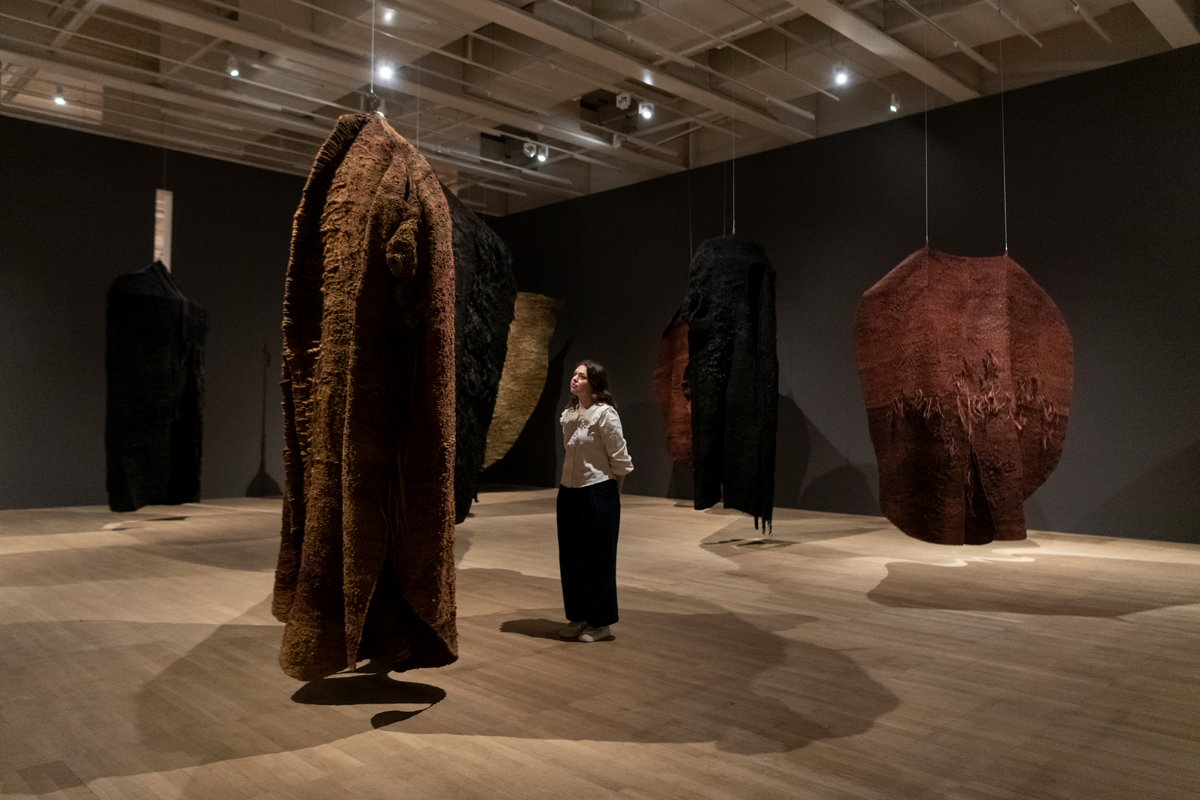
Magdalena Abakanowicz: Every Tangle of Thread and Rope, installation view. © Tate Photography, Madeline Buddo.
Born in 1930, Abakanowicz’s childhood years were marked by the Second World War, part of which she spent at her family’s seventeenth-century manor deep in the woods, near the villa of Krępa, until the family fled for Warsaw in 1944 after German soldiers invaded their home and shot her mother’s arm off. The forest, once a bucolic place of mystery and legend, now also harbored trauma and fear: “Strange powers dwelled in the woods and lakes that belonged to my parents,” Abakanowicz wrote years later about her connection to nature. “Apparitions and inexplicable forces had their laws and their spaces. . . . Among the plants and the animals, everything was good. Man, I was unable to fathom.” The few overtly figurative works at Tate Modern—such as Hand (1975), made of raw sisal coiled into an oversized fist, and Head (1976), a puckered, mummy-like visage of burlap and resin—hint at the violent fragmentation of both body and psyche that lurks within Abakanowicz’s rough, hovering forms: the Abakans proper, which dominate the remainder of the exhibition.
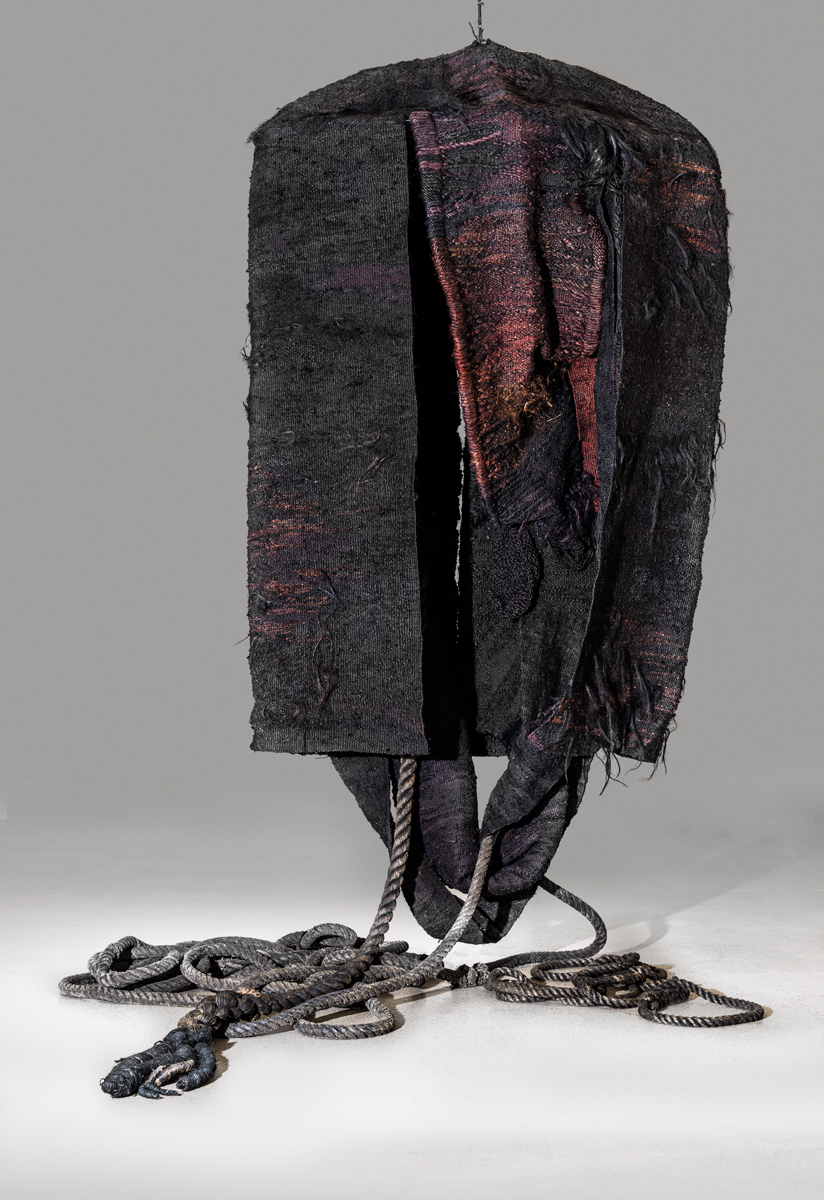
Magdalena Abakanowicz, Abakan – Situation Variable II, 1971. Sisal and rope. Courtesy the city of Biel-Bienne, Switzerland. © Fundacja Marty Magdaleny Abakanowicz Kosmowskiej i Jana Kosmowskiego.
In a long, darkened space, twelve later works in hues of mauve, black, brown, and crimson are suspended vast and monumental, clustered in an environment or a “situation.” As Abakanowicz said: “an Abakan is an independent entity, but it is also one of the elements by which we can conceive of space.” The raking light on these rough sisal, rope, and burlap figures reveals intensely textured surfaces pocked and pitted with fissures and growths, coils and carbuncles. Abakan – Situation Variable II (1971) spills dark spools of rope and swathes of fabric from its innards, one dark side gaping to reveal tight interior spirals, blood-red and frayed. Winter (1975–80) hangs colossal and stolid like a shroud, tightly stitched down the middle with a spinelike strata of thick horizontals, fibers shimmering mercurial shades at once pewter, olive, bronze.
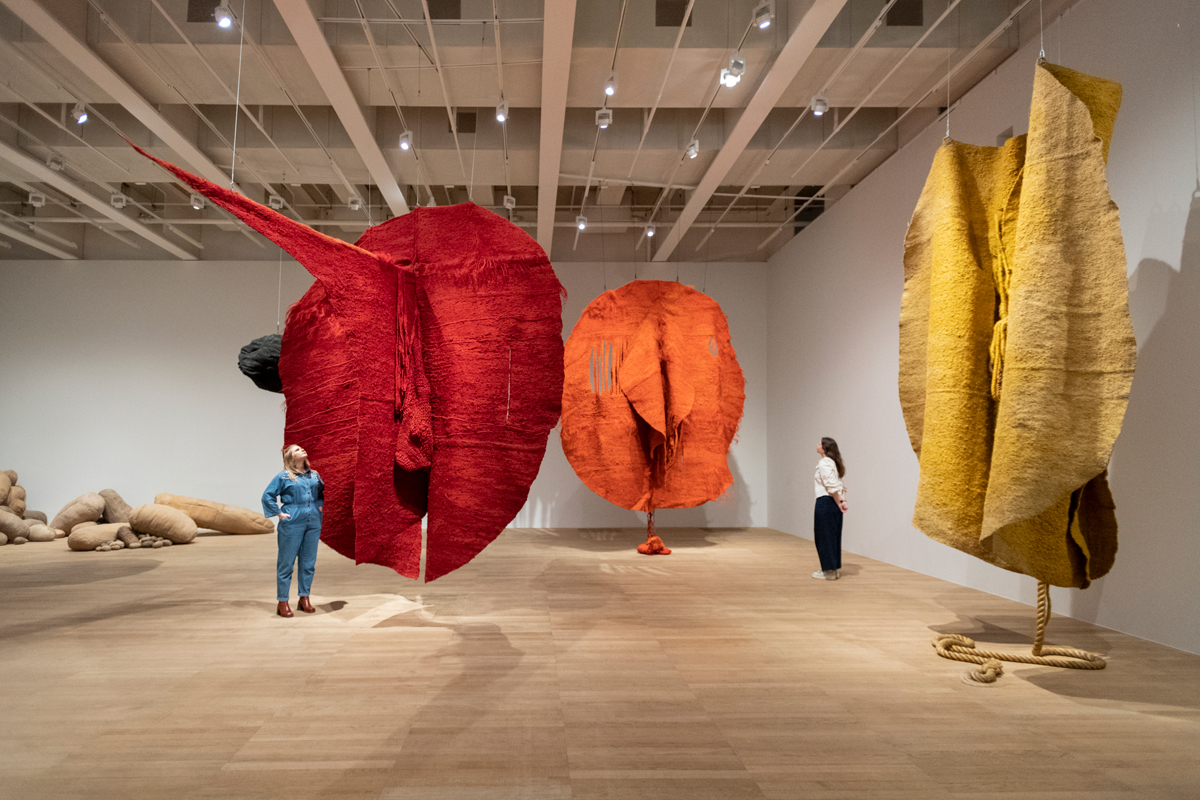
Magdalena Abakanowicz: Every Tangle of Thread and Rope, installation view. © Tate Photography, Madeline Buddo.
“I see fiber as the basic element constructing the organic world on our planet, as the greatest mystery of our environment,” said Abakanowicz. “Handling fiber we handle mystery. . . . Fabric is our covering and our attire. Made with our hands, it is a record of our souls.” Abakans is the naming of a thing after oneself, but also the naming of oneself after a thing—it is, I am, we are: Abakan Round, Abakan Green, Abakan Festival, Abakan Open, Abakan Brown. The final room is dominated by five radiant, enormous Abakans in orange, red, yellow, and black that evoke, variously, a pair of lungs, a nose, testicles, veins, tendons, vaginal openings—the inchoate reality of bodies. “Art does not solve problems but makes us aware of their existence,” the artist said. It is, I am, we are: corporeal, tender, funny, grotesque, alive, imperiled, enduring, animated by interior forces that can only be apprehended with the stuff of life, which is also to say art, without category and compromise.
Emily LaBarge is a writer based in London. She has written for Artforum, Bookforum, the London Review of Books, and the Paris Review, among other publications. Dog Days will be published in the UK be Peninsula Press in 2024. An excerpt is forthcoming in the Winter 2023 issue of Granta.